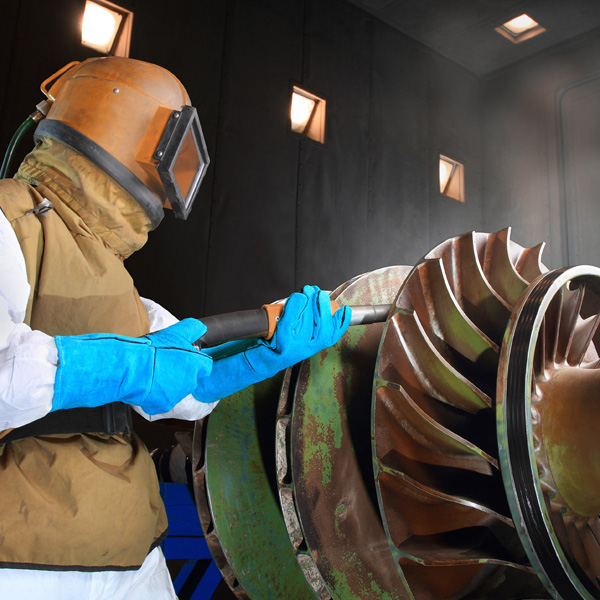Industrial Application Of Dust Collector
Abrasive Blasting Dust Collection System

Abrasive blasting, shot peening, vibratory cleaning, sanding, buffing, grinding, and other surface preparation methods are known for generating high levels of dust in manufacturing. These processes demand specialized dust collection solutions to effectively manage the substantial amounts of fine nuisance dust produced.
Aluminium Dust Collection System

Aluminum, the most abundant metal on earth, finds extensive application in both durable and consumer goods. Its utilization in automobiles and aircraft is on the rise, while its presence in beverage containers and other food-related applications remains consistent. In essence, aluminum is a staple material that manufacturers must handle safely as its relevance persists.
Shot Blast Dust Collection System

Shot blasting, sandblasting, and other dust-producing operations necessitate effective dust collection systems. Dust collection during abrasive blasting is crucial for capturing the blasting material and debris dislodged from the surfaces being treated.
Carbon Black Dust Collection System

Carbon black, a fine powder utilized in the production of numerous everyday items, is predominantly employed in rubber applications, with tires being a primary example, as reported by the International Carbon Black Association. Additionally, around nine percent of carbon black is utilized as pigments in paints and inks.
Chemical Dust Collection System

Chemical manufacturers are well aware of the inherent risks associated with chemical production, including threats to health, safety, and property. Chemicals exhibit a broad spectrum of toxicity levels and potential physical harm, underscoring the importance of prioritizing workplace exposure control.
Fertilizer Dust Collection System

Fertilizer dust collection has been hailed by some as the most notable agricultural. This type of fertilizer offers a distinctive dual-release of nutrients for plants.It is crucial to acknowledge that the base material, nitrate, is also a key component in the production of explosives, highlighting the importance of considering this factor when addressing fertilizer dust collection.
Cast Iron Grinding Dust Collection System

The utilization of cast iron in the construction industry remains consistent. working with cast iron poses inherent risks. As with any metalworking operation, precautions must be taken to ensure the safety of workers. Various methods are available to enhance air quality in metalworking facilities.
Food Processing Dust Collection System

Dust control in food processing is crucial for ensuring both food safety and worker health and safety. Unregulated food dusts can lead to various issues such as sanitation risks, cross-contamination, microbial contamination, health hazards for employees, and slip-and-fall accidents.
Fumed Silica Dust Collection System

Fumed Silica Dust Collection utilizes robust blowers and advanced filters to effectively purify the air over a broad area. Certain facility layouts may present more intricate challenges than others, and if you are unsure about the specific location of dust accumulation.
Glass making Dust Collection System

The production of glass presents various hazards, with a particular emphasis on the dust generated by the ingredients employed in the process. The primary components consist of a few chemicals and a significant quantity of crystalline silica. The dust particles originating from these materials are typically very fine and have the potential to become airborne easily.
Graphite Dust Collection System

Graphite, a naturally occurring allotrope of carbon, distinguishes itself as a valuable material. Although not as costly as its counterpart, diamond, graphite possesses exceptional properties such as conductivity, heat resistance, and lubricating capabilities.
Iron and Chrome Dust Collection System

Iron and chrome continue to be extensively utilized and are expected to maintain their relevance as long as manufacturing sectors persist. Iron is employed in various forms, ranging from bulk and cast iron to powdered carbonyl iron, particularly in electronic applications.
Metalworking Dust Collection System

Metalworking stands out as one of the most hazardous manufacturing processes for workers. Whether it involves grinding or laser cutting, the fine particulates released during these operations have significant implications. While the primary concern is the health of workers, these dust particles also pose a threat to the overall well-being of a company.
Laser Cutting Dust Collection System

Laser cutting is an increasingly popular industrial process due to its enhanced production efficiency, reduced consumable costs, and lower direct labor expenses through automation, among other benefits. Enhancing air quality should be a top concern in the contemporary manufacturing landscape.
Fiberglass Fine Grinding Dust Collection and Filtration System

Effective dust collection and extraction are essential in fiberglass fine grinding within manufacturing facilities, require excessive maintenance. The ultra-fine particulates produced during fiberglass fine grinding can pose challenges for both workers and equipment.
Nickel Dust Collection System

Nickel is extensively utilized in manufacturing and is present in numerous everyday products. This silvery metal serves as a crucial element in various alloys, notably stainless steel, due to its corrosion resistance properties. Nickel is employed as a plating material and is a common component in batteries.
Pharmaceutical Dust Collection and Filtration System

Pharmaceutical Dust Collectors utilize ultra-high efficiency Nano-Elite filter media for capturing sub-micron particles. Safety HEPA after filters can be provided as needed. Our engineers assist in designing systems constructed from stainless steel, ensuring corrosion resistance and compliance with explosion protection standards.
Pigment Dust Collection System

The hazards associated with pigment dust are akin to those posed by various toxic metals. For instance, even at low concentrations, cadmium dust can impact the kidneys and respiratory system. Prolonged exposure may lead to adverse effects on the neurological, reproductive systems, and is linked to lung and prostate cancers.
Polymer Dust Collection System

Manufacturers and researchers have made significant advancements in developing novel polymers. The introduction of these new products, coupled with continuous enhancements to existing ones, indicates that polymers will continue to have extensive applications in the foreseeable future.
PVC Grinding Dust Collection System

PVC Grinding dust collection can be customized for individual use or integrated into a comprehensive facility-wide grid system. Dust collectors enhance the operational efficiency of your manufacturing facility, benefiting both product quality and employee well-being. The presence of clean air promotes worker health, reduces the risk of source material contamination.
Silica Dust Collection System

Silica, a ubiquitous substance on Earth, is utilized in numerous industrial applications. It serves as the primary component in glass and plays a significant role in the production of ceramic tile, cement, bricks, and asphalt. Widely employed in metallurgy, agriculture, and water filtration, silica also finds application in advanced technologies like fiber optics.
Talc Dust Collection System

Talc is a versatile mineral that plays a crucial role in various industrial processes, including the production of plastics, ceramics, paper, rubber, and more. Its presence in ceramics enables lower firing temperatures and enhances thermal expansion properties. Talc is utilized in paper manufacturing to reduce surface friction.
Thermal Spray Dust Collection & Ventilation System

Thermal spray processes are typically carried out in a spray booth or enclosed space. This setup enables the containment of thermal spray dust and fumes for effective source capture. In a source capture system, air is extracted in close proximity to the source and filtered to eliminate contaminants.
Welding Fumes Dust Collection System

Welding fume dust collector, the suction motor pulls contaminated air through a washable stainless steel shot mesh filter to capture large dust particles. Subsequently, the air passes through a fine filter to remove fine dust particles. These charged particles move to a set of parallel plates acting as collection plates.
Woodworking Dust Collection System

The woodworking dust collection system should be carefully chosen and sized by experts. Moreover, sawdust and wood particles are highly combustible, necessitating robust fire and explosion protection in industrial woodworking dust collection systems. Industrial woodworking generates particles of varying sizes, ranging from wood chunks to fine powder.
Mining Dust Collection System

The mining industry entire infrastructure for processing mined materials and ores into usable raw materials. Mined materials range from sand, gravel, stone, and coal to metals like iron, lead, copper, gold, silver, platinum, aluminum, zinc, lithium, nickel, molybdenum, manganese, cadmium, beryllium, chromium, tin, and tungsten.
Paper Dust Collection System

Industrial collectors are essential for the proactive maintenance of paper dust. Certain paper-processing facilities, especially those handling chemically treated paper, may need to comply with OSHA regulations by utilizing an industrial vacuum cleaner designated as "explosion-proof" for cleaning hazardous-rated zones
Powder Coating Dust Collection System

Powder coatings require utmost care during handling. These chemical compounds are applied to a surface electrostatically and cured with heat to create a durable coating. Integral to numerous manufacturing processes.
Grinding and Deburring Dust Collection System

Grinding dust consists of small particles of metal and disc/wheel material. When these particles are reduced to sizes smaller than 5 microns, the dust becomes respirable. Dust generated during grinding and deburring processes can pose health and safety risks, necessitating the implementation of an efficient dust collection system.
Sanding and Finishing Dust Collection System

sanding and finishing operations, significant amounts of dust are generated and released into the air stream. The fine dust circulates and settles on floors and surfaces, posing health risks and causing production challenges. Sanding and finishing dust is typically submicron in size, rendering it invisible to the naked eye and extremely hazardous upon overexposure.
Flour Mill Dust Collection System

The flour mill dust collector is primarily employed to effectively collect flour dust, there by enhancing the air quality in the working environment. The flour mill dust collector is favored for its high level of automation, cost-effectiveness, and resistance to corrosion.
Foundry Dust Collection System

Foundry dust collection systems are essential in metal casting foundries to manage various processes. Foundry dust collection presents unique challenges, such as high temperatures and a substantial dust load. It commonly encounter both sand and metal dust.
Combustible Metal Dust Collection System

Combustible metal dusts can exhibit explosive properties. Metals such as aluminum, bronze, magnesium, silicon, and zinc have the potential to be explosive. In certain conditions, magnesium and aluminum can be even more explosive than common substances like flour or sugar.
Gold Dust Collection System

Gold Dust Collector captures dust particles at the source and passes them through a two-stage filtration process. This two-stage filtration system effectively captures and recovers particles of all sizes without any loss. The collector is compact, easily portable, and provides an efficient and cost-effective solution for recovering gold dust.
Master Batch Dust Collection System

Master Batch production process substantial quantities of airborne dust, particulate matter, and fumes. Dust collection systems within the masterbatch industry are engineered to capture and eliminate these pollutants, thereby ensuring compliance with regulations and fostering a cleaner, healthier working environment.
Carbon Black Dust Collection System

Carbon Black Association reports that ninety percent of carbon black is employed in rubber-related applications. Manufacturers start with dense petroleum products and process them into an odorless black powder with diverse particle sizes.
Rubber and plastic Dust Collection System

Dust generated from rubber and plastic processing may contain fibrous materials, presenting a handling challenge. These fibers and streamers can become trapped between the pleats of standard cartridge filters, making them resistant to removal during pulse cleaning.
Grain and seed Dust Collection System

Grain and seed dust collection storage, a bin venting dust collector is essential. This dust collector is installed directly on the top of the bin, hopper, or silo to capture airborne particles within the enclosure. Bin venting is crucial to mitigate the risk of a combustible dust explosion within the storage facility.

